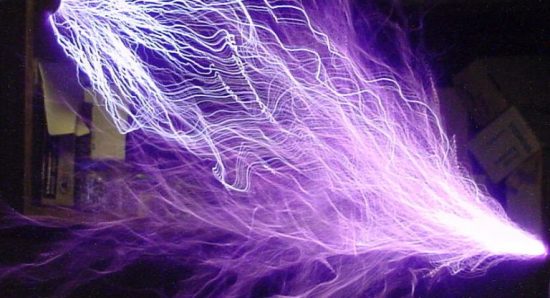
Easter Egg Hunt in Laramie Mountains
by Andrew Hall
In the final chapter of the Eye of the Storm series, I presented Easter eggs — surprise geologic findings that confirmed a theory or presented astonishing new information about Earth’s electric circuitry. Exploring the Electric Earth is a perpetual egg hunt because every rock confirms that the Bunny is REAL.
Electrical discharges follow patterns and behaviors that yield definitive information about cause and effect. Discharge patterns on the landscape indelibly record discharge events, like a holographic data bank.
Chapters 8 and 9 of Eye of the Storm discussed surface conductive discharges across Earth’s surface that formed the Colorado River and its tributaries. The trace of a surface conductive discharge is particularly rich in information. Unlike a lightning bolt that momentarily sticks on the Earth, a surface discharge has to crawl across the surface, meeting significant impedance, seeking out conductive pathways, expending vast energies transporting matter, while explosively faulting and excavating. It takes time; it is not energy-efficient and leaves its mark.
A stunning display of a particular type of surface conductive discharge can be found in the Laramie Mountains in Wyoming (Figure 1). Embedded in these mountains are gorges and ridge-lines that literally form a phase diagram of what took place. It couldn’t be more explicit than if God had left his blueprint on the drafting table for all to see. This fifteen-mile cross is from a discharge between two out-of-phase circuits.
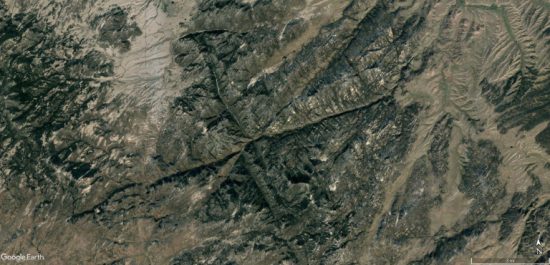
First, however, let’s consider the geometry of a surface conductive discharge. Each discharge branches out in fractal, self-similar dendrites, to absorb all the surface charge on the conductive object it’s attached to (Figure 2a) — in our case, the Earth. This is diffusion-limited aggregation. Each filament of a discharge soaks up charge from a particular domain. The domain is a region surrounding the spark defined by its electromagnetic field, from which it sucks charge of one polarity and spits charge of the other polarity in reactive power surges. It does this because it’s not insulated current as we use in electrical systems.

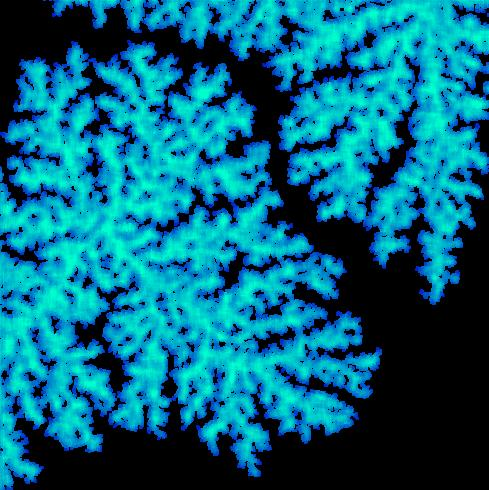
Filament domains cover every square inch of solid land on the planet. We call them watersheds, because they serve to collect rain waters into river channels, but that’s a consequence, not a cause. The Earth once crawled with electrical discharges. This should be self evident in any theory of planetary formation. In consensus theories, planet and comet collisions would necessitate big sparks. In Electric Universe theory, sparks are already acknowledged. Why consensus science doesn’t look for evidence of electrical discharge is evidence it doesn’t ask the right questions.
What is interesting — the big Easter Egg I’m getting to — is that domains cross and the filaments interact. Giant sparks result. The interaction we’ll investigate created a landscape that can only be explained electrically. The statistical probability of consensus theories doing it is nigh impossible.
Domains don’t usually cross, because skin effects occur between domains that keep them segregated as if by a membrane (Figure 2b). But they can cross and interact if domains are out of balance. An over-voltage in one could make it aggressive and overcome another. Depending on phase disparities, this can be a gentle hand-holding connection, or it can be an explosive punch. Let’s look at one of the explosive kinds.
The Laramie Range — Shot Through The Heart
The annotated image in Figure 3 shows the area of interest, circled in violet, including the Laramie Mountains surrounded by green and red circles. The Laramie’s are part of the Continental Divide as it cuts through southeastern Wyoming. The circles denote the major streams flowing from the mountains. Green are streams flowing to the North Platte, and thence to the Missouri River and ultimately the Mississippi Valley and the Gulf of Mexico. Red are streams that flow to a sink in the basin west of the mountain range. The sink forms the Seminoe and Pathfinder Reservoirs, also circled in red west of the mountains, and the North Platte River forms the Glendo Reservoir on the opposite side, circled in green.
The high basin drains around the mountains in two flows (yellow connections.) North Platte runs near Casper, Wyoming around the north of the mountains, and the Laramie flows from Medicine Bow to Fort Laramie through a pass to the south of the range. The overall structure is shaped like a heart, with the mountains filling the upper half, the basin filling the lower, and the rivers acting as arteries and veins.
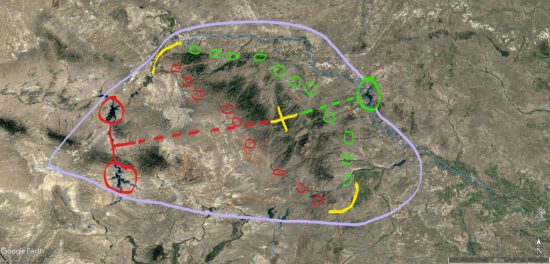
“X” Marks the Spot
The distinctive yellow “X” in the center of the range in Figure 3, is a discharge pattern that occurred when the North Platte filament of the Mississippi discharge met a separate domain with a different phase. What you see is literally a natural phase diagram that records the phase angles of the discharge. The discharge took place because the Missouri circuit was an AC current that made connection to a ground current in the basin, and sparks shot between the circuits where their domains came together. The Laramie Mountains formed as a consequence.
The discharge adopted an “X” pattern where it made connection, with east-west branches vectored along the electric field denoted by the dotted red and green lines in Figure 3. The electric field is the dipolar alignment between the lakes. The lakes, or the depressions where these lakes are situated, were created in the same discharge event that met at the crux of the “X” and sent reactive discharges rotated at 90-degrees to the originating spark between the circuit domains. The discharge is much like the “resonant frequency discharges” discussed in Chapters 8 and 9 of Eye of the Storm, which created the major 180-degree (or nearly so) branches of the Colorado River (Figure 4).
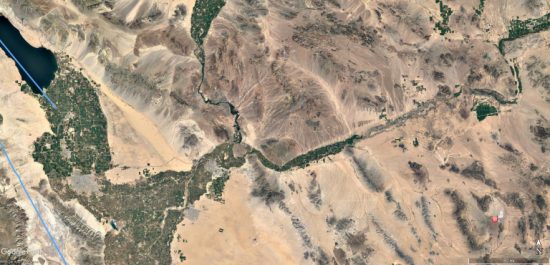
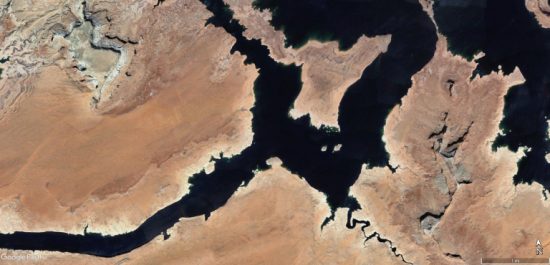
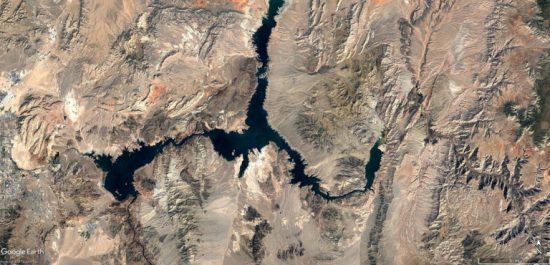
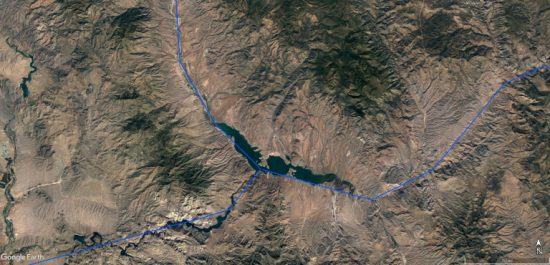
The images in Figure 4 demonstrate resonant frequency discharges that bifurcate into inductive and capacitive reaction currents. The geometry is different, an “X” instead of a “T”, but that is because the “X” is a resonant discharge between two existing circuit domains, whereas the “T” is a result of a single circuit bifurcating.
The bifurcating discharge meets critical resistance due to a build-up of stray capacitance that resonates the circuit, increasing frequency and therefore resistance until the current is stopped, causing it to explode in reactive discharges 90-degrees to either side of the original current, as shown in Figures 4.
The “X” is produced by two out-of-phase circuit domains coming together. The Missouri circuit is an alternating current, whereas the basin circuit is a direct current-to-ground. The two circuits go in and out of phase with each other as the AC current alternates. This makes a connection, then a discharge. The discharge is totally in the reactive power mode because the out-of-phase circuits are 180-degrees out-of-phase and that has the same effect as resonant discharge, raising resistance to infinity and forcing the current out sideways at 90-degrees.
The first case is like putting a finger over the nozzle of a hose and forcing water to spray out sideways, 90-degrees to the direction of the nozzle. The second case is like having two hoses aimed at each other, and where the streams impact, flow sprays out sideways. In one, the blocked water pressure changes flow direction and makes a “T”, and the other, two flows impact and the pressure changes flow direction to make an “X”.
The reactive discharge dissolves the voltage differential between circuits by expending their charge -– the entire accumulated charge in the Missouri circuit, in this case –- in an explosive “X” shaped spark.
It created what astrophysicists call “magnetic reconnection.” Astrophysicists don’t recognize electric circuitry in space because, in dark mode, current doesn’t emit radiation they can detect. Since they can’t see it, their reductionist minds can’t make the intuitive leap to circuitry, but they do detect the magnetic flux that results. They invented the term “magnetic reconnection” in lieu of an explanation because they can’t fathom the simplicity of two out-of-phase circuits coming together to make a spark.
Figure 5 is a .gif of so-called “magnetic reconnection.” The moving lines are magnetic field lines –- the things astrophysicists think are re-connecting –- but they are actually the magnetic field lines generated by current flow-oriented along the dotted lines. Their model only recognizes magnetism, so the dotted lines are just separators of the magnetic field in their .gif. The big yellow arrows pointed inwards and outwards in different quadrants of the “X” are the vectors of electric current induced by the changing magnetic field.
In the Laramie’s, induced currents were expressed in the atmosphere by plasma winds. Plasma winds drew to the crux of the discharge at ground level in the top and bottom quadrants and blew outwards at a high level like an anvil cloud in the right-left quadrants. The winds lifted in a vertical updraft over the center of the “X”. But even more astounding is the effect that magnetic fields and reactive currents had shaping the entire basin and range structure. The landscape is a 3-D photograph of what happened.
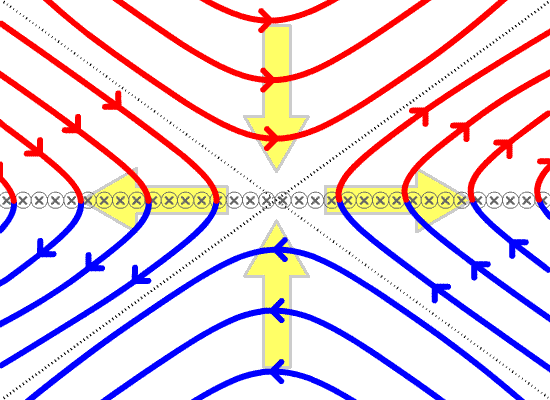
To appreciate what took place, the three-dimensional nature of the circuit domains needs to be recognized. Charge diffused across the ground, as well as through the ground and into the sky. Capacitance between the Earth and sky forced mirroring currents in the atmosphere, stirring a violent storm system. Think of it as a local squall line of thunderstorms raging over the mountains at the time they were formed and while the ground discharge took place. The central updraft over the “X” formed a huge mesocyclone, flanked by smaller thunderheads to either side. Most of the energy of the discharge went straight up, into the mesocyclone, pulsing it with energy. The wind paths to be described are ground-level winds, shaped by the electromagnetic field at the planet’s surface.
The combined effect of the discharge at ground level, its magnetic field, and the resultant plasma winds are shown in Figure 6. The discharge makes the “X” pattern, shown in red. The magnetic field lines (blue) are as shown in Figure 5 as the pattern of so-called “magnetic reconnection.” The wind vectors are shown in yellow.
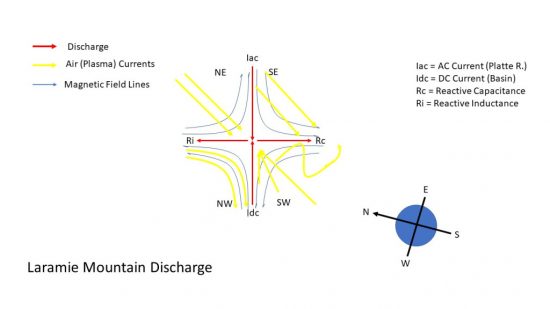
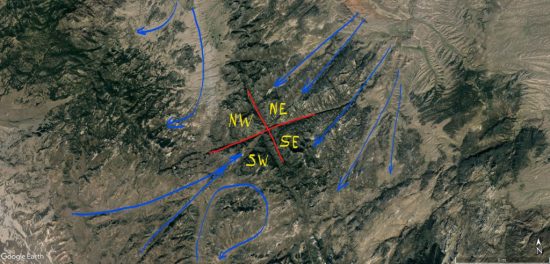
Figure 7 shows how these winds patterned around the “X”. The winds in the NE and SE quadrants flow parallel. In the NE, they cross magnetic field lines perpendicularly, flowing straight to the crux of the discharge. These winds were narrow jet streams that cut valleys as shown in Figure 8.
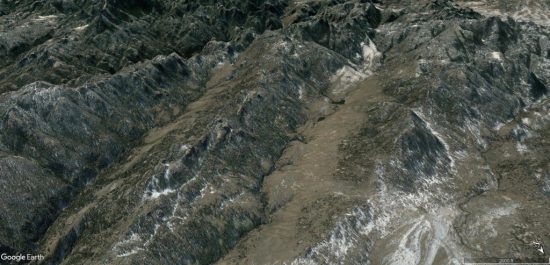
Jet stream winds leave valleys like shown in Figure 8, with broad rounded, or “V’ cut bottoms carpeted with silt, but no inner gorge. They may have superficial, meandering stream erosion, but not a deep, straight, inner gorge. We’ll examine more wind cut valleys later, but first let’s distinguish between wind cut valleys and the discharge blasted canyons that form the “X”.
The path of a discharge leaves canyons rough cut, with a deep inner gorge as shown in Figure 9. This is the Platte River or northeastern arm of the “X”.
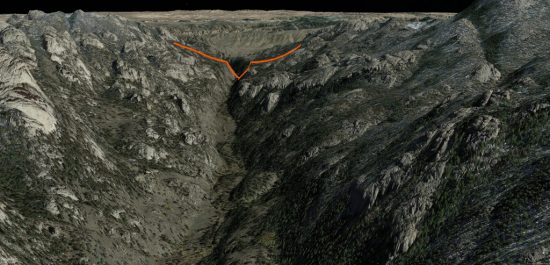
The sides of the discharge canyon indicate arc blast which exposed granite tetrahedrons. On one side the tips of tetrahedrons (leeward side) jut out, exposed, and broken (Figure 10b), whereas the other side shows the flat faces of windward tetrahedrons (Figure 10a). This indicates the mountains were laid down by a cross-wind before the discharge occurred and blasted this canyon. So, the mountains resulted from an evolving storm system that changed its winds, surely due to this big spark. Note the cross-hatch patterns of shock diamonds in the canyon flanks.
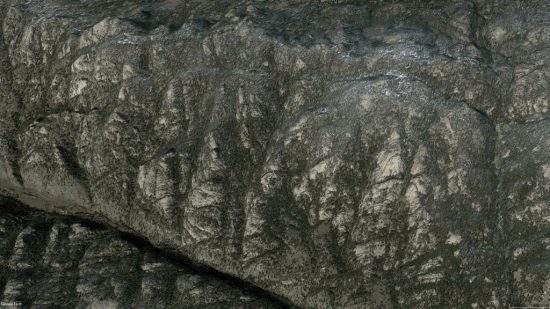
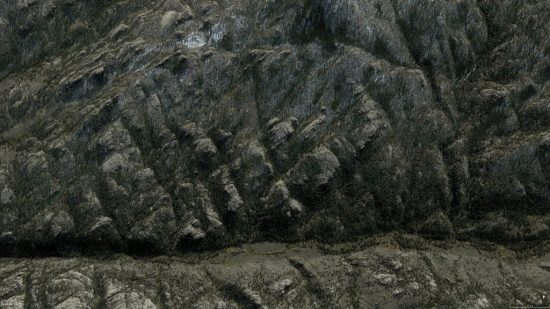
Figure 11 shows NE quadrant wind-cut valleys between the north and east arms of the “X” discharge. Note the many transverse striations of cuts and gorges and how they change orientation between arms of the discharge. Striations come from deposition layers shaped by shock waves transverse to winds, and secondary discharge filaments between circuit paths.
Winds drew into a central vortex at the crux of the discharge, drawing dust into a pile to form the mountain. Therefore, each quadrant of the discharge displays shock waves oriented by the wind in that quadrant.
Secondary discharges are from short-circuiting sparks between current paths, like sparks between live, bare wires that are too close together. There is one secondary discharge visible that makes its own “X” pattern, center right in the image. This is a mini-discharge between the AC current in the big “X” and the static build-up of charge in the wind cut lane due to the plasma jet stream. It’s essentially an AC to DC connection that makes a perfect 90-degree reaction just like the big “X”. It’s even in the same orientation — repeating, self-similar forms.
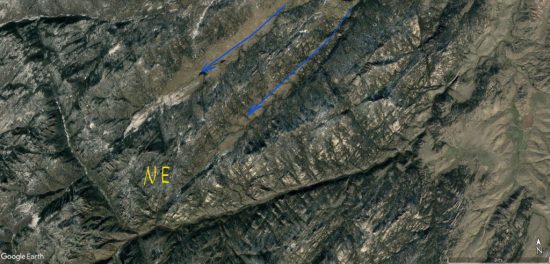
In Part 2, we’ll look at more Easter eggs in the Laramie Mountains.
Additional Resources by Andrew Hall:
YouTube Playlists through 4-2022:
Andrew Hall — EU Geology and Weather
Andrew Hall — Eye of the Storm Episodes (13)
Surface Conductive Faults | Thunderblog
Arc Blast — Part One | Thunderblog
Arc Blast — Part Two | Thunderblog
Arc Blast — Part Three | Thunderblog
The Maars of Pinacate, Part One | Thunderblog
The Maars of Pinacate, Part Two | Thunderblog
Nature’s Electrode | Thunderblog
The Summer Thermopile | Thunderblog
Tornado — The Electric Model | Thunderblog
Lightning-Scarred Earth, Part 1 | Thunderblog
Lightning-Scarred Earth, Part 2 | Thunderblog
Sputtering Canyons, Part 1 | Thunderblog
Sputtering Canyons, Part 2 | Thunderblog
Sputtering Canyons, Part 3 | Thunderblog
Eye of the Storm, Part 1 | Thunderblog
Eye of the Storm, Part 2 | Thunderblog
Eye of the Storm, Part 3 | Thunderblog
Eye of the Storm, Part 4 | Thunderblog
Eye of the Storm, Part 5 | Thunderblog
Eye of the Storm, Part 6 | Thunderblog
Eye of the Storm, Part 7 | Thunderblog
Eye of the Storm, Part 8 | Thunderblog
Eye of the Storm, Part 9 | Thunderblog
Eye of the Storm, Part 10 | Thunderblog
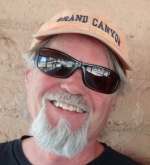
Andrew Hall is a natural philosopher, engineer, and writer. A graduate of the University of Arizona’s Aerospace and Mechanical Engineering College, he spent thirty years in the energy industry. He has designed, consulted, managed, and directed the construction and operation of over two and a half gigawatts of power generation and transmission, including solar, gasification, and natural gas power systems. From his home in Arizona, he explores the mountains, canyons, volcanoes, and deserts of the American Southwest to understand and rewrite an interpretation of Earth’s form in its proper electrical context. Andrew was a speaker at EU2016, EU2017 and the EUUK2019 conferences. He can be reached at hallad1257@gmail.com or thedailyplasma.blog
Disclosure: The proposed theories are the sole ideas of the author, as a result of observation, experience in shock and hydrodynamic effects, and deductive reasoning. The author makes no claims that this method is the only way mountains or other geological features are created.
Ideas and/or concepts presented in Thunderblogs do not necessarily express or represent the Electric Universe model or the views of The Thunderbolts Project or T-Bolts Group Inc.












